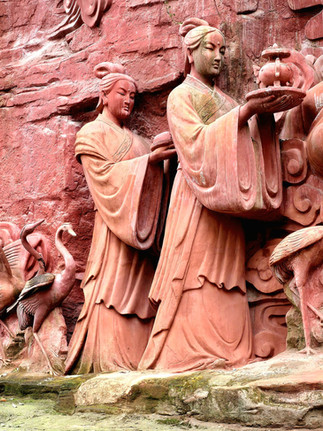Baoguo - Temple of Divine Mountain
- Shannon
- May 3
- 3 min read
Updated: Oct 9
Sacred Stillness at the Base of Mount Emei
Situated at the foothills of Mount Emei, the Baoguo Temple serves as a gateway to one of China's Four Sacred Buddhist Mountains and stands as testament to the rich history and spiritual heritage of the region. Originally founded around 100AD, the current temple complex underwent extensive restoration during the Ming Dynasty in the 16th century, under the watchful eye of Emperor Kanxi.

This historically significant and revered temple was constructed to enshrine the sacred relics of the Buddha and is famously linked to the Bodhisattva Samantabhadra (or Puxian), the patron deity of the mountain and universal virtue. Local myths suggest Samantabhadra himself once visited the temple, blessing the monks and ensuring the temple's continued prosperity.

The temple's name translates to "High and Precious"
The Baoguo Temple is known for housing several rare relics, including some of the oldest surviving Buddhist scriptures in China. These scriptures, hand-copied over a thousand years ago, were once lost to history after many libraries and temples in the region were ravaged by war and natural disasters. In 2010, however, an ancient scroll was rediscovered in a hidden chamber within the temple, its preservation a mystery. It also houses an important collection of statuary and ritual objects dating back to the 5th and 6th centuries.
The temple's architecture is an intriguing blend of traditional Chinese styles, yet incorporates subtle influences from the indigenous culture of Sichuan province. Unlike the more common Tang Dynasty style, Baoguo Temple’s main hall exhibits characteristics that suggest a fusion between Han and Tibetan Buddhist architectural elements. Its imposing wooden beams, heavy golden accents and intricate roof designs feature elements that are typically seen in Tibetan monasteries. This architectural cross-pollination hints at the cultural exchange between Han and Tibetan Buddhist practices in the region long before the rise of the Tibetan Buddhist monasteries in the 17th century.
Baogao Temple stands as a bridge between the earthly and divine realms, a place where the physical world and spiritual world converge. Whether through the miracles attributed to its sacred relics or the spiritual wisdom imparted by its monks, the temple continues to be a symbol of peace, faith and the eternal connection between humanity and the divine.

Xiujia Waterfall
🗺️ Location
Emeishan City, Leshan, Sichuan Province, China
🚆 How to get there
The easiest way to reach Baoguo Temple from Emeishan City is to take a Didi taxi directly to the Baoguo Temple bus station, located just a short walk from the temple entrance. This is a convenient option if you’re carrying luggage or prefer door to door transport. Alternatively, regular public buses, routes 5A and 12, run frequently from various points in the city. The ride takes about 20 minutes and costs just ¥1.5 per person, making it an affordable and efficient way to get to the base of Mount Emei.
⭐ Attraction Info
As of 2025, entrance to Emeishan National Park costs ¥185 per adult, which grants access to the broader mountain area, including scenic trails, monasteries and cable car routes. If you're only visiting Baoguo Temple, located at the foot of the mountain, the temple itself has a separate entry fee of just ¥8. The temple is open daily from 6am - 6:30pm during the high season (typically April to October) and between 7am - 6pm during the low season (November to March). It's best to allow at least one to two hours to properly explore the temple complex, which includes multiple halls, courtyards and ancient relics. The site is well maintained with paved paths and minimal steps, making it accessible for visitors of all ages and mobility levels.
报国寺
These beautiful red stone carvings adorn the side of a cliff near the Fuhu Temple, on the way out of Baoguo Temple
Thanks for reading Baoguo - Temple of Divine Mountain. Check out more awesome destinations here!






















